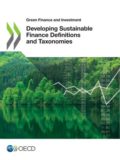
Bron
OECD
A number of countries have created official definitions of sustainable finance as well as more comprehensive classification systems, referred to as sustainable finance taxonomies. A new report by the OECD maps sustainable finance definitions and taxonomies in five jurisdictions: the European Union, People’s Republic of China, Japan, France and the Netherlands.
Taxonomies answer a need for greater certainty on the environmental sustainability of different types of investments. When appropriately designed, they can improve market clarity, bring confidence and assurance to investors, and facilitate the measurement and tracking of sustainable finance flows. The report lays out preliminary considerations for good design of taxonomies, which can support policy makers to develop and grow sustainable finance markets to help achieve environmental and sustainable development goals. It also identifies differences among the taxonomies in scope as well as commonalities. These commonalities could provide a basis for creating comparable frameworks that facilitate international investment while also reflecting differing national circumstances.
In recent years, investors have increasingly taken actions to integrate climate change and broader sustainability concerns into their investment decisions and portfolio allocations. However, there is a widely perceived need for greater certainty on the environmental sustainability of different types of investments and economic activities. In response, a number of jurisdictions have started to legislate to create official definitions of sustainable finance. This new report maps sustainable finance definitions and taxonomies in five jurisdictions: the EU, China, Japan, France and the Netherlands.
Taxonomies are definitions of sustainable finance that aim to be comprehensive classification systems, while definitions of sustainable finance are less ambitious in scope. When appropriately designed, sustainable finance definitions and taxonomies can bring potential benefits. These include improving market clarity. More precise and consistent definitions of which investments are “green” and “sustainable” could facilitate investment by giving confidence and assurance to investors. Other potential benefits include easier tracking of sustainable finance flows to be able to measure them or to take a policy action such as setting incentives.
Recognising some of those potential benefits, the European Union (EU) adopted a regulation in June 2020 to establish a framework to facilitate sustainable investment. This regulation, often referred to as “the EU Taxonomy Regulation”, is the cornerstone of the EU Sustainable Finance Action Plan, as it will feed into several forthcoming regulatory initiatives such as the EU Green Bond Standard, the EU Ecolabel for retail investment funds and others. Several other jurisdictions also have addressed sustainable finance taxonomies and definitions. In China in 2015, the People’s Bank of China issued the first iteration of its Green Bond Endorsed Project Catalogue, commonly referred to as “the Chinese taxonomy”. In Japan in 2017, the Ministry of the Environment of Japan (MOEJ) launched Japan’s green bond guidelines. The Netherlands has had a legislative approach to green lending since 1995 (Green Funds Scheme), and France created the GreenFin label for retail investment funds in 2015. Other countries expressing interest on sustainable finance taxonomies include Canada, Kazakhstan and Indonesia, among others.



